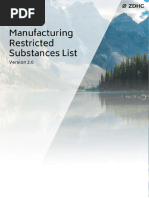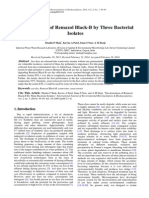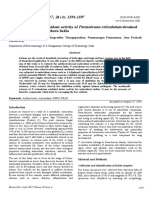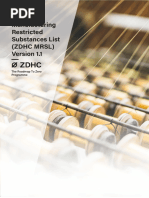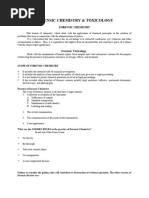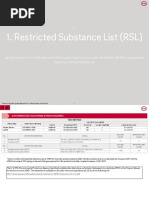2 Tina Mukherjee
2 Tina Mukherjee
Uploaded by
IJAMCopyright:
Available Formats
2 Tina Mukherjee
2 Tina Mukherjee
Uploaded by
IJAMCopyright
Available Formats
Share this document
Did you find this document useful?
Is this content inappropriate?
Copyright:
Available Formats
2 Tina Mukherjee
2 Tina Mukherjee
Uploaded by
IJAMCopyright:
Available Formats
Indian Journal of Applied Microbiology
ISSN (Online): 2454289X, ISSN (Print): 22498400
Copyright © 2019 IJAM, Chennai, India Volume 22 Number 1
April - June 2019, pp. 10-19
Decolorization of triphenylmethane dyes using
immobilized cells of bacterial consortium
Tina Mukherjee1* and Manas Das2
Scottish Church college, 1 & 3 Urquhart Square, Kolkata-700006
Department of Chemical Engineering, University of Calcutta (Retd.)
Abstract: The use of freely suspended microbial cells for dye removal is limited owing to their
inherent disadvantages such as clogging of cells, low mechanical strength of the biomass etc.
Immobilized cells offer advantages over dispersed cells such as high cell density, strong
endurance of toxicity for being high in numbers, lower operating costs, simple maintenance
management and production of smaller residual sludge. In this study immobilized cell mass of a
bacterial consortium, isolated from dye contaminated wastewater, was used to decolorize a
mixture of triphenylmethane dyes: Malachite Green, Crystal violet and Basic Fuchsin. Among all
the matrices studied calcium alginate showed maximum decolorization with immobilized
biomass. Therefore, cells immobilized on calcium alginate matrix was considered for studying the
removal of triphenylmethane dyes. Effects of various parameters viz. alginate concentration, bead
size, bacterial cell numbers, initial dye concentration, time, pH and temperature were investigated
in batch system. The optimum conditions for removal of the dyes were found to be pH 8,
temperature 37°C, alginate concentration of 2% (w/v), a cell concentration of 1×109 cells/ml. The
dye removal capacity of the immobilized cells decreased as the initial dye concentration
increased.
Keywords: Triphenylmethane dyes, immobilization, decolorization
Introduction
Triphenylmethane dyes are used extensively in the textile industries for dyeing of nylon,
polyacrylon nitrile, modified nylon, wool, silk and cotton [1]. Some of the triphenylmethane dyes
*Author for Correspondence. E-mail: tina.m@rediffmail.com
www. ijamicro.com
Decolorization of triphenylmethane dyes using immobilized cells of bacterial consortium 11
are used in medicine and forensics as biological stains. Gasoline, paper and leather industries are
the major consumer of triphenylmethane dyes. Triphenylmethane dyes are also one of the widely
used dermatological agents [2]. Gentian Violet and Malachite Green have been used in topical
application on domestic animals against various infections. These have been used effectively for
controlling the fungal growth under varying conditions [3]. Gentian Violet has also been applied
to poultry feed for controlling fungal contamination. Hence, human population gets directly or
indirectly exposed to the dyes through their widespread therapeutic and commercial use.
However, studies confirmed the cytogenetic toxic nature of Gentian violet, which states that that
this compound is a mitotic poison as well as a clastogen in vitro [2]. Its clastogenic properties
were confirmed in five other different mammalian cell types. Gentian Violet has been regarded as
biohazardous substance [3]. Most of the triphenylmethane dyes are animal carcinogens [4]. There
are many instances in which researchers have found their acute toxicity against fishes and
mammals. Based on research findings, malachite green had been found to cause carcinogenic
symptoms on laboratory mice [5]. Malachite green showed toxicity to many fish species, even
when used at recommended doses under different environmental conditions especially pH and
temperature [6].
Traditional wastewater treatment facilities are, however, unable to completely remove commercial
dyestuff including triphenylmethane dyes such as Crystal Violet, Malachite Green from
contaminated wastewater, thus contributing to pollution of aquatic habitats. However, among all
the processes used to treat effluent containing dyes, biological processes are getting more
attention as they are cost effective, environment friendly and do not produce large amount of
sludge [7, 8].
Use of immobilized biomass for decolorization of dyes is gaining more attention these days. In
recent years, several studies have shown that the mechanism for the decolorization of dyes using
immobilized microorganisms may include both biodegradation and adsorption [7, 9]. Verma et al.
[10] studied immobilization of Phanerochaete chrysosporium (MTCC 787) over loffa sponge for
efficient and repeated use of the biomass for removal of triphenylmethane dyes. Loffa sponge is
an inert natural cellulosic fiber matrix, obtained from ripen fruits of Loffa cylendrica.
Immobilization of the fungal biomass over the matrix improved efficiency of the biomass due to
less dense fiber packing as compared to the free fungal biomass. Immobilized yeast Candida
tropicalis grown on sugarcane bagasse extract medium, was employed to remove synthetic dye
Basic Violet 3 by Charumathi and Das in 2010 [11].
In our study, six different bacterial cells isolated from dye contaminated wastewater were used as
a bacterial consortium and immobilized on various matrices in order to find out the most suitable
one and various parameters were optimized in batch system.
INDIAN JOURNAL OF APPLIED MICROBIOLOGY Vol. 22 No. 1 April - June 2019
12 TINA MUKHERJEE AND MANAS DAS
Materials and methods
Dyes used
Triphenylmethane dyes namely Malachite Green Oxalate (MG), Crystal Violet Chloride (CV) and
Basic Fuchsin (BF) Chloride were procured from Merck, India. These dyes were mixed together
in equal proportions to make a stock concentration of 500 mg/L.
Isolation, acclimatization and selection of the microorganisms
Dye contaminated wastewater was collected from different places (Jaggubazar-Kolkata, Habra,
Tentulia, Titagarh, and Sodepur- North 24 Pgs, West Bengal – all small scale dying industries) and
the samples were used for isolating potent strains which can remove the triphenylmethane dyes,
namely Malachite Green Oxalate, Crystal Violet Chloride and Basic Fuchsin Chloride [12]. The
bacterial strains collected were grown and maintained in Nutrient Agar medium.
Preparation of medium for growth and removal study
Mineral salt medium composition for growth and removal studies consist of (g/L): KCl - 0.5,
NaNO3 - 2, MgSO4, 7H20 - 0.5, FeSO4, 7H2O - 0.01 and MG,CV,BF of varying amounts (0.05-0.5
g/L).
Organisms
Six different highly tolerant bacterial strains to TMR dyes were isolated and grown in mineral salt
medium containing dye mix for 24 hr. The bacterial strains were determined by HiMedia DT 005,
DT 011 identification discs and DT012 identification discs and were found to be E. coli,
Staphylococcus aureus, Pseudomonas aeruginosa, Bacillus subtilis, Klebsiella pneumoniae and
Enterobacter asburiae. In 50 ml Mineral salt medium containing dyes 0.5 ml of each of the
bacterial strains was added (approximately 0.8X109 cells/ml). Biomass was harvested by
centrifugation at 8000 rpm for 10 min. After washing with normal saline the required amount of
biomass was used for immobilization.
Immobilization of biomass
a. Immobilization on Carboxymethyl cellulose (CMC)
3% CMC solution mixed with bacterial suspension at a concentration of about 1×109cells/ml. The
CMC-bacteria mixture was injected using a hypodermic syringe drop-wise to FeCl3 solution
(0.05 M) to form beads. The beads entrapped with bacterial cells (immobilized) were cured in the
FeCl3 solutions for 1hr to enhance their mechanical stabilities. Diameter of beads varied from 2 -
5 mm.
b. Immobilization on Calcium alginate
Sodium alginate solution (3%) of 6 ml was mixed with 3 ml bacterial suspension in normal saline
at a concentration of about 1 ×109 cells/ml. The Sodium alginate bacteria mixture was gently
INDIAN JOURNAL OF APPLIED MICROBIOLOGY Vol. 22 No. 1 April - June 2019
Decolorization of triphenylmethane dyes using immobilized cells of bacterial consortium 13
dropped into 0.2 M CaCl2 solution using a hypodermic syringe allowing beads to be formed. The
diameter of the beads ranged from 2 – 5 mm. The beads were cured in 0.2M CaCl2 solution for 2
hr to enhance their mechanical stabilities.
c. Immobilization on Agar and agarose
4.5% agar solution was prepared by dissolving required amount of agar in distilled water by
boiling. Then 6 ml of 4.5% agar solution at 42°C was mixed with 3 ml normal saline solution
containing 1×109cells/ml. After solidification of the agar, 3×3×3 mm3 cubes were cut and washed
with normal saline. Same procedure was followed with 4.5% agarose solution as matrix instead of
agar.
Decolorization of dye mix using immobilized cells of bacterial consortium
For decolorization study, immobilized cells were added to 50 ml of dye containing mineral salt
medium in 100 ml Erlenmeyer flask. After decolorization, the broth was centrifuged at 8000 rpm
for 10 min. Clear supernatant was used for determination of dye removal in terms of %
decolorization using UV-Visible spectrophotometer (U-4100, Hitachi). MG, CV and BF in a
single solution were scanned from 300-700 nm, where from maximum absorption (λmax) was
obtained at 585 nm. The % decolorization was calculated using the following expression:
% decolorization = [(initial absorbance-observed absorbance) /initial absorbance] ×100
Each experiment was conducted in triplicate and mean values were taken. For controls, samples
containing no immobilized beads and sample containing no dye were run simultaneously with the
experimental samples. The former control was given to see nonspecific dye removal by
components in the medium, while the latter showed the growth of the bacterial strain in media
lacking triphenylmethane dyes.
After selecting the suitable matrix for immobilization of the bacterial cells based on removal
efficiency, it was used for further studies to obtain other parameters such as initial concentrations
of dyes, contact time, pH, temperature, alginate concentration and cell concentration in a 50 ml
TPM mineral salt medium and maintained at a rotation speed of 130 rpm.
3. Results and discussion
Screening of different matrices for immobilization of bacterial consortium for dye
removal
The dye removal was conducted in batch process and the most suitable matrix to determine dye
decolorization was screened. Various matrices viz. CMC, agar, agarose and calcium alginate were
screened for the immobilization of bacterial consortium for effective entrapment and removal.
Among all matrices tested, alginate showed highest dye removal efficiency (89.2%) in this study
followed by agar (85.4%), CMC (76%) and agarose (71%) (Figure 1).
INDIAN JOURNAL OF APPLIED MICROBIOLOGY Vol. 22 No. 1 April - June 2019
14 TINA MUKHERJEE AND MANAS DAS
Figure 1. Screening of immobilization matrix for effective dye removal, initial dye
concentration 50 mg/L.
Effect of Alginate concentration on dye removal
The effect of sodium alginate concentration on immobilization was studied by varying the
concentration from 1% to 5%. To determine the optimum alginate concentration, in an 100 ml
Erlenmeyer flask 50 ml Mineral salt medium was taken and approximately 1 gm of alginate bead
was added which contains 0.8X109 mixed bacterial cells per ml at a pH of 7 and a temperature of
35 C for 24 hrs under shaking condition at 130 rpm . Too low sodium alginate concentration
resulted in very soft beads while sodium alginate concentration above 3% caused hardening of the
beads creating diffusion problems. At high sodium alginate concentration (>4%), efficiency
dropped as the substrate has difficulty in diffusing through the beads. However, when only 1.0%
sodium alginate concentration was used, the beads obtained were too soft and thus were easily
broken because of their low mechanical strength resulting leakage of bacterial cells from the
beads. Maximum dye removal was noted in case of 2% sodium alginate concentration when
initial dye concentration was 50 mg/L (Figure 2).
Figure 2. Effect of alginate concentration on dye decolorization
INDIAN JOURNAL OF APPLIED MICROBIOLOGY Vol. 22 No. 1 April - June 2019
Decolorization of triphenylmethane dyes using immobilized cells of bacterial consortium 15
Effect of cell concentration on removal
The effect of cell concentration in immobilized beads was investigated by varying the cell
concentration from 0.8×109 to 1.2 ×109 cells per ml of bacterial consortium. For determining the
effect of cell concentration on dye decolorization, a 100 ml Erlenmeyer flask containing 50 ml
Mineral salt medium containing TPM dyes was taken and approximately 1 gm of alginate bead
was added at a pH of 7 and a temperature of 35 C for 24 hrs under shaking condition at 130
rpm. An increase in cell concentration increased the dye removal efficiency well up to the
concentration of 1×109 cells per ml of culture (Figure 3). Further increase in cell concentration did
not increase the dye removal efficiency. The dye removal efficiency remained almost unaffected
by increase in cell numbers beyond 1×109 cells per ml of culture.
Figure 3. Effect of cell count on dye decolorization
Effect of initial dye concentration
In order to study the effect of initial concentration of triphenylmethane dyes, the experiments
were carried out at a cell concentration which contains approximately 1×109 bacterial cells/ml of
bacterial culture. In an Erlenmeyer vessel of 100 ml 50 ml mineral salt medium containing
triphenylmethane dyes was taken and approximately 1 gm of alginate bead was added at a pH of
7 and a temperature of 35 C for 24 hrs under shaking condition at 130 rpm.
Below this 50 mg/L, dye decolorization was 100% in all the concentrations tested under the same
condition. Figure 4 demonstrate the effects of initial dye concentration on decolorization. It was
found that immobilized biomass was capable of decolorizing up to only 800 mg/L. The
decolorization at the lowest (50 mg/L) and highest dye concentration (800 mg/L) was 92% and
13.5%, respectively. A number of studies have been carried out to determine the decolorization of
various dyes with immobilized microorganisms. Very few reports are available that shows the
decolorization of Triphenylmethane dyes with immobilized bacterial biomass. It has been stated
by Chheriaa et al.(2012) that when Malachite Green and Crystal violet were treated separately by
INDIAN JOURNAL OF APPLIED MICROBIOLOGY Vol. 22 No. 1 April - June 2019
16 TINA MUKHERJEE AND MANAS DAS
bacterial consortium they obtain 99% and 91% decolorization respectively when used at a
concentration of 50 mg/L [13]. In this study while we use the immobilized biomass at 50 mg/L of
mixed dye concentration, (they were not used separately, they were used in a mixed solution) we
also obtain a good amount of decolorization (92%). Another study made by Chen et al. [14] used
Polyvinyl alcohol immobilized microorganisms and obtain good decolorization efficiency (75%)
for an azo dye RED RBN, here also a single dye sample was used.
In our study we used immobilized bacterial consortium to determine the decolorization of mixed
dye solution, where we also obtain good decolorization at lower concentrations of dyes which
gets reduced at higher dye concentration. Under immobilized condition, as the organisms are
trapped into alginate beads they were not capable of multiply and increase their numbers.
Therefore, although the dye concentrations increase, due to lack of increasing cell numbers the
immobilized biomass failed to show decolorization at high concentration of dyes, which can be
attributed to the lower observed decolorization efficiency in this case.
Figure 4. Effect of initial dye concentrations on TPM dye decolorization
Effect of exposure time on dye removal
In order to study the effect of time on dye decolorizaion by immobilized bacterial cells the
experiments were carried out at various dye concentrations at pH 7, a temperature of 35°C and a
shaking speed of 130 rpm. When studied, it was found that the immobilized cells of bacterial
consortium was able to decolorize more than 90% of the dye from the solution when used in a
concentration of 50 mg/L within 12 hr. No more decolorization was obtained after that. Good
decolorization efficiency was also obtained in a dye concentration of 100 mg/L which also
required 12 hr to decolorize. It has been found that as the initial dye concentration increased the
required time for decolorization also increased (Figure 5). Negligible decolorization was obtained
in case of 800 mg/L and that was obtained after 24 hr of incubation. It can be said that as dye
concentrations increased more time is required by the immobilized biomass to decolorize such
concentrated dye solutions.
INDIAN JOURNAL OF APPLIED MICROBIOLOGY Vol. 22 No. 1 April - June 2019
Decolorization of triphenylmethane dyes using immobilized cells of bacterial consortium 17
Figure 5. Effect of exposure time on dye decolorization
Effect of pH
The experiment was performed in 100 ml Erlenmeyer flasks containing 50 ml dye mix containing
Mineral salt medium where concentration of the dye was 50 mg/L at 35 C. The medium was
inoculated approximately 1 gm of immobilized beads which contains approximately 1×109
bacterial cells/ml of bacterial culture. It was observed that the percentage of dye decolorization
varied with change in pH of the medium (Figure 6). The decolorization rate peaked around pH 8
within 24 hr; the organisms decolorized 92.5% of the dye from the medium. Additionally, the
organisms also showed good decolorization efficiency at pH 7 (90.2%). Therefore, in the range of
pH neutral to mild alkaline the immobilized organisms were proved to be an efficient decolorizer
of triphenylmethane dyes. Most of these dyes found in the effluent are basic in nature. Therefore,
in this case the immobilized consortium can be used effectively in case of treatment of industrial
effluent.
Figure 6. Effect of pH on dye decolorization
INDIAN JOURNAL OF APPLIED MICROBIOLOGY Vol. 22 No. 1 April - June 2019
18 TINA MUKHERJEE AND MANAS DAS
Effect of temperature
The immobilized organisms were capable of carrying out decolorization over a broad temperature
range (20-45ºC).The optimum temperature for the removal of the dye was found to be 37ºC
(88.9% dye decolorization) (Figure 7), good decolorization efficiency was obtained in range of
37- 40 C . This is a convenient temperature of most tropical countries during most of the time
throughout the year, except for winter. Therefore, this ambient temperature could be considered as
beneficial for dye industries to carry dye decolorization operations with immobilized biomass.
Figure 7. Effect of temperature on dye decolorization
Conclusion
The present study confirms the effective decolorizing capacity of the bacterial biomass which was
immobilized on calcium alginate matrix. Very few reports are available demonstrating the
effectiveness of immobilized bacterial consortium as decolorizer of mixed triphenylmethane dyes.
This study represents a suitable means by which triphenylmethane dye mix can be decolorized
with the help of immobilized bacterial biomass. The most suitable condition for decolorization
was also documented. The optimum conditions for removal of TPM dyes were found to be at pH
8, temperature 37°C, alginate concentration of 2% (w/v), a cell concentration of 1×109 cells/ml.
Maximum removal was obtained when dye concentration was 50 mg/L within 24 hr of
incubation.
Acknowledgement
The author is highly grateful to Scottish Church College authority and all staff members of
Microbiology Department of Scottish Church College for their support and University Grant
Commission for providing financial assistance to conduct the Minor Research Project under
F.PSW-123/15-16 (ERO).
Conflicts of interest
The authors declare no conflicts of interest.
INDIAN JOURNAL OF APPLIED MICROBIOLOGY Vol. 22 No. 1 April - June 2019
Decolorization of triphenylmethane dyes using immobilized cells of bacterial consortium 19
References
1. Gregory, P. 1993, Dyes and dyes intermediates. In: Encyclopedia of Chemical Technology Vol. 8
(Kroschwitz, J. I., Ed.). John Wiley & Sons. New York, pp 544-545.
2. Azmi W., Sani R.K., and Banerjee U.C., 1998, “Biodegradation of Triphenylmethane dyes”
Enzyme and Microbial Technology, 22, pp.185-191.
3. Willian, A. U., Pathak, S., Cheryl, J., and Hsu, T. C. 1978, “Cytogenic toxicity of Gentian Violet
and Crystal Violet on mammalian cells in vitro”. Mutant. Res., 58, pp. 269-276.
4. Parshetti G., Kalme S., Saratale G. and Govindwar S., 2006. “Biodegradation of malachite green
by Kocuria rosea MTCC 1532”, Acta. Chim. Slov., 53, pp.492–498.
5. Culp S.J., Blankenship L.R., Kusewitt D.F., Doerge D.R., Mulligan L.T. and Beland F.A., 1999,
“Toxicity and metabolism of malachite green and leucomalachite green during short-term feeding
to Fischer 344 rats and B6C3F1 mice” Chem. Biol. Interact., 122, 3, pp 153–170.
6. Srivastava A.K., Sinha R., Singh N.D., Roy D., Srivastava S.J., 1995b,” Malachite green induced
changes in carbohydrate metabolism and blood chloride levels in the freshwater catfish
Heteropneustes fossilis” Acta Hydrobiol., 37, 2, pp 113–119.
7. Chen C.Y., Kuo J.T., Cheng C.Y., Huang Y.T., Ho I.H. and Chung Y.C., 2009, “Biological
decolorization of dye solution containing malachite green by Pandoraea pulmonicola YC32 using
a batch and continuous system”, J. Hazard Mater. , 172, pp. 1439–1445.
8. Wu J., Jung B.G., Kim K-S, Lee Y-C and Sung N-C, 2009, ”Isolation and characterization of
Pseudomonas otitidis WL-13 and its capacity to decolorize triphenylmethane dyes “J. Environ.
Sci., 21, pp. 960–964.
9. Pazarlioglu N.K., Urek R.O., Ergun F., 2005, “Biodecolourization of Direct Blue 15 by
immobilized Phanerochaete chrysosporium”, Process Biochem., 40, pp.1923–1929.
10. Verma D.K. and Banik R.M. “Decolorization of triphenylmethane dyes using immobilized fungal
biomass”, ijrimsec.com/assoc_art/volume2/ijr13-4.pdf.
11. Charumathi D. and Das N., 2010.” Removal of synthetic dye Basic Violet 3 by immobilized
Candida tropicalis grown on sugarcane bagasse extract medium” IJEST, 2 (9), pp. 4325-4335.
12. Mukherjee T. and Das M. 2018, “Microbial decolorization of triphenylmethane dyes”, IOSR-JBB,
4(2), pp.57-63.
13. Chheria J., Khaireddine M., Rouabhia M. and Bakhrouf A., 2012.”Removal of Triphenylmethane
Dyes by Bacterial Consortium”. The Sci.World J. Article D 512454, pp 1-9.doi :
10.1100/2012/512454.
14. Chen K –C , Wua J –Y , Huang C –C , Liang Y –M and John Hwang S –C .2003,
“Decolorization of azo dye using PVA-immobilized microorganisms” J. of Biotech., 101, pp 241-
252
INDIAN JOURNAL OF APPLIED MICROBIOLOGY Vol. 22 No. 1 April - June 2019
You might also like
- ZDHC MRSL Version 2.0Document44 pagesZDHC MRSL Version 2.0afaizallNo ratings yet
- Exer 2 Morphology and Reproduction of YeastsDocument45 pagesExer 2 Morphology and Reproduction of YeastsLennon Davalos80% (5)
- Namita JaggiDocument4 pagesNamita JaggiIJAMNo ratings yet
- TMP 6 B19Document5 pagesTMP 6 B19FrontiersNo ratings yet
- Antidermatophytic Activity of Acacia Concinna: V. Natarajan and S. NatarajanDocument2 pagesAntidermatophytic Activity of Acacia Concinna: V. Natarajan and S. NatarajanRajesh KumarNo ratings yet
- Long Chain Fatty Alcohols From Eupatorium Odoratum As Anti-Candida AgentsDocument4 pagesLong Chain Fatty Alcohols From Eupatorium Odoratum As Anti-Candida AgentsAnju S NairNo ratings yet
- Removal of Methylene Blue From Aqueous Solution by Dehydrated Maize TasselsDocument8 pagesRemoval of Methylene Blue From Aqueous Solution by Dehydrated Maize TasselsDaney RosalesNo ratings yet
- TMP 9 ADBDocument6 pagesTMP 9 ADBFrontiersNo ratings yet
- Isolation and Development of A Bacterial Consortium For Biodegradation of Textile Dyes Reactive Red 31 and Reactive Black 5Document9 pagesIsolation and Development of A Bacterial Consortium For Biodegradation of Textile Dyes Reactive Red 31 and Reactive Black 5IOSRjournalNo ratings yet
- Microencapsulation of The Allelochemical Compounds and Study of Their Release From Different ProductsDocument9 pagesMicroencapsulation of The Allelochemical Compounds and Study of Their Release From Different ProductsFrontiersNo ratings yet
- DownloadDocument4 pagesDownloadmounikad.openventioNo ratings yet
- Removal of Triazine Herbicides From Freshwater Systems Using Photosynthetic MicroorganismsDocument6 pagesRemoval of Triazine Herbicides From Freshwater Systems Using Photosynthetic MicroorganismsDanaNo ratings yet
- Screening of Antibacterial Antituberculosis and Antifungal Effects of Lichen Usnea Florida and Its Thamnolic Acid ConstituentDocument6 pagesScreening of Antibacterial Antituberculosis and Antifungal Effects of Lichen Usnea Florida and Its Thamnolic Acid ConstituentJoe ScaliaNo ratings yet
- Cytotoxic and Antimicrobial Activity of The Crude Extract of Abutilon IndicumDocument4 pagesCytotoxic and Antimicrobial Activity of The Crude Extract of Abutilon IndicumApurba Sarker ApuNo ratings yet
- A Consortium of Thermophilic Microorganisms For Aerobic CompostingDocument8 pagesA Consortium of Thermophilic Microorganisms For Aerobic CompostingIOSRjournalNo ratings yet
- Antioxidant, Antimicrobial Activity andDocument7 pagesAntioxidant, Antimicrobial Activity andDidi Haryo TistomoNo ratings yet
- 469 G Kola GbedemDocument4 pages469 G Kola GbedemStephen Yao GbedemaNo ratings yet
- Chemrj 2017 02 03 133 143Document11 pagesChemrj 2017 02 03 133 143editor chemrjNo ratings yet
- V8i203 2Document5 pagesV8i203 2Aried EriadiNo ratings yet
- Journal of Nanotechnology - 2013 - Devaraj - Synthesis and Characterization of Silver Nanoparticles Using Cannonball LeavesDocument5 pagesJournal of Nanotechnology - 2013 - Devaraj - Synthesis and Characterization of Silver Nanoparticles Using Cannonball LeavesAbuBakar BuzdarNo ratings yet
- Mythili International Research Journal of PharmacyDocument5 pagesMythili International Research Journal of PharmacymythiliNo ratings yet
- Silymarin Natural Antimicrobiol Agent Extracted From Silybum MarianumDocument6 pagesSilymarin Natural Antimicrobiol Agent Extracted From Silybum MarianumJoha Castillo JaramilloNo ratings yet
- 2015 2 Gloriosa Superba PDFDocument8 pages2015 2 Gloriosa Superba PDFPriaNo ratings yet
- Phytochemical Screening and Antimicrobial Activities Of: Terminalia Catappa, Leaf ExtractsDocument5 pagesPhytochemical Screening and Antimicrobial Activities Of: Terminalia Catappa, Leaf ExtractsOlapade BabatundeNo ratings yet
- A Sensitive and Quick Microplate Method To Determine The Minimal Inhibitory Concentration of Plant Extracts For BacteriaDocument3 pagesA Sensitive and Quick Microplate Method To Determine The Minimal Inhibitory Concentration of Plant Extracts For BacteriaCesar MartinezNo ratings yet
- VaralakDocument7 pagesVaralaknurul islamNo ratings yet
- ICTROPS - Antimicrobial Activity and Phytochemical Properties of Actinodaphne Glomerata Leaves ExtractDocument4 pagesICTROPS - Antimicrobial Activity and Phytochemical Properties of Actinodaphne Glomerata Leaves ExtractJulinda manaluNo ratings yet
- 08.20 Letters in Applied Nanoscience Volume 9, Issue 4, 2020, 1583 - 1594 PDFDocument12 pages08.20 Letters in Applied Nanoscience Volume 9, Issue 4, 2020, 1583 - 1594 PDFSathyabama University BiotechnologyNo ratings yet
- Paper 8844Document6 pagesPaper 8844IJARSCT JournalNo ratings yet
- Brine Shrimp Cytotoxicity Activity For Different Parts of Hymenocallis LittoralisDocument6 pagesBrine Shrimp Cytotoxicity Activity For Different Parts of Hymenocallis LittoralisRAPPORTS DE PHARMACIENo ratings yet
- Antimicrobial Activity of Lemon Peel (Citrus Limon) Extract: Original ArticleDocument4 pagesAntimicrobial Activity of Lemon Peel (Citrus Limon) Extract: Original ArticleFortunato Flojo IIINo ratings yet
- PHYTOCHEMICAL AND CYTOTOXICITY TESTING OF RAMANIA LEAVES (Bouea Macrophylla Griffith) ETHANOL EXTRACT TOWARD VERO CELLS USING MTT ASSAY METHODDocument6 pagesPHYTOCHEMICAL AND CYTOTOXICITY TESTING OF RAMANIA LEAVES (Bouea Macrophylla Griffith) ETHANOL EXTRACT TOWARD VERO CELLS USING MTT ASSAY METHODLaila FitriNo ratings yet
- Devaraj 2013Document6 pagesDevaraj 2013Stefania ArdeleanuNo ratings yet
- 11.19 Indian Journal of Chemical Technology, Vol. 26, November 2019, Pp. 544-552Document9 pages11.19 Indian Journal of Chemical Technology, Vol. 26, November 2019, Pp. 544-552Sathyabama University BiotechnologyNo ratings yet
- Extraction of Algal Pigments and Their Suitability As Natural DyesDocument8 pagesExtraction of Algal Pigments and Their Suitability As Natural DyesEustache NIJEJENo ratings yet
- 336 PDFDocument6 pages336 PDFDonovon AdpressaNo ratings yet
- Asian Journal of ChemistryDocument5 pagesAsian Journal of ChemistryDr. Yedhu Krishnan RNo ratings yet
- GarlicDocument11 pagesGarlicFarandy ArlianNo ratings yet
- Antibacterial and Antioxidant Activity of Parmotrema Reticulatum Obtained F PDFDocument5 pagesAntibacterial and Antioxidant Activity of Parmotrema Reticulatum Obtained F PDFIrin TandelNo ratings yet
- Analysis of Rhamnolipid Biosurfactants Produced-OrangeDocument12 pagesAnalysis of Rhamnolipid Biosurfactants Produced-OrangeAdrian Bermudez LoeraNo ratings yet
- A Study OnDocument4 pagesA Study OnJiff Solis TrinidadNo ratings yet
- Phytochemical and Antibacterial Evaluation of Various Extracts of Amoora Rohitukaa BarkDocument5 pagesPhytochemical and Antibacterial Evaluation of Various Extracts of Amoora Rohitukaa Barkumeshbt720No ratings yet
- Phytochemical Compositions, Nutritional Contents, Cytotoxicity and Anti-InflammatoActivity of DiDocument10 pagesPhytochemical Compositions, Nutritional Contents, Cytotoxicity and Anti-InflammatoActivity of Diบุษรา ยงคําชาNo ratings yet
- Original Research Article: Lucida BenthDocument19 pagesOriginal Research Article: Lucida BenthmelendezjmanuelNo ratings yet
- 045 ChongDocument8 pages045 ChongSandi Gusti AriyandaNo ratings yet
- Aplication Plackett BurmanDocument8 pagesAplication Plackett BurmanBurcu TaşçıNo ratings yet
- 2 Tom Sinoy Research Article Mar 2011Document9 pages2 Tom Sinoy Research Article Mar 2011Riski BagusNo ratings yet
- 1 SMDocument4 pages1 SMAbraham YirguNo ratings yet
- Antioxidant and Cytotoxic Effects of Methanol Extracts of AmorphophallusDocument4 pagesAntioxidant and Cytotoxic Effects of Methanol Extracts of AmorphophallusDidar SadiqNo ratings yet
- 1781 3332 1 SM PDFDocument6 pages1781 3332 1 SM PDFMuh ArfandyNo ratings yet
- Application of Magnetic Stirrer For Influencing Extraction Method OnDocument4 pagesApplication of Magnetic Stirrer For Influencing Extraction Method OnCarla MetarNo ratings yet
- Mudita PDFDocument17 pagesMudita PDFNi Nyoman SuryaniNo ratings yet
- Microbial Degradation Spectral AnalysisDocument12 pagesMicrobial Degradation Spectral AnalysisBekele Oljira NegeroNo ratings yet
- Studies On Bio-Ethanol Production From Orange Peels Using Bacillus SubtilisDocument5 pagesStudies On Bio-Ethanol Production From Orange Peels Using Bacillus SubtilisAnoif Naputo AidnamNo ratings yet
- Antimicrobial Activities of Extracts and Flavonoid Glycosides of Corn Silk (Zea Mays L)Document7 pagesAntimicrobial Activities of Extracts and Flavonoid Glycosides of Corn Silk (Zea Mays L)ji jiNo ratings yet
- Phytochemical Screening in Drumstick PeelDocument9 pagesPhytochemical Screening in Drumstick PeelAllia AsriNo ratings yet
- Antibacterial Activity and Phytochemical Analysis of Euphorbia Hirta Against Clinical PathogensDocument7 pagesAntibacterial Activity and Phytochemical Analysis of Euphorbia Hirta Against Clinical PathogensEditor IJTSRDNo ratings yet
- Nomila Merlin Et Al. - 2013 - Optimization of Growth and Bioactive Metabolite Production Fusarium SolaniDocument6 pagesNomila Merlin Et Al. - 2013 - Optimization of Growth and Bioactive Metabolite Production Fusarium SolaniKarenina MarcinkeviciusNo ratings yet
- Decolourization of Azo Dye Methyl Red byDocument7 pagesDecolourization of Azo Dye Methyl Red byEvelyn NathaliaNo ratings yet
- AzoxystrobinDocument6 pagesAzoxystrobinlabet.calidadNo ratings yet
- In Vitro Anti-Leishmanial and Anti-Tumour Activities ofDocument5 pagesIn Vitro Anti-Leishmanial and Anti-Tumour Activities ofchem_dream10No ratings yet
- PradeepaDocument7 pagesPradeepaIJAMNo ratings yet
- Anuradha NDocument4 pagesAnuradha NIJAMNo ratings yet
- Niveditha ArticleDocument2 pagesNiveditha ArticleIJAMNo ratings yet
- 1 BavejaDocument9 pages1 BavejaIJAMNo ratings yet
- Dyeing of FabricsDocument33 pagesDyeing of FabricsBathrinath 007100% (1)
- ZDHC MRSL V2.0Document50 pagesZDHC MRSL V2.0Zubaer AlamNo ratings yet
- Methods For Detection of Common Adulterants in FoodDocument6 pagesMethods For Detection of Common Adulterants in FoodVIVA-TECH IJRINo ratings yet
- Test Report: Softlines Wastewater TestingDocument15 pagesTest Report: Softlines Wastewater TestingMusaNo ratings yet
- ZDHC MRSL v02 March 2020Document48 pagesZDHC MRSL v02 March 2020Nazmul hasanNo ratings yet
- MRSL 20240214Document35 pagesMRSL 20240214Muhammad Saqib AsifNo ratings yet
- F. Chem Investigatory ProjectDocument23 pagesF. Chem Investigatory ProjectAaron SamNo ratings yet
- SARAF Webinaire 1 March 2022 FAQ DocumentDocument8 pagesSARAF Webinaire 1 March 2022 FAQ DocumentNguyen Hien Duc HienNo ratings yet
- Verde de Malaquita - Sigma Aldrich-115942-EnDocument2 pagesVerde de Malaquita - Sigma Aldrich-115942-EnDiegoNo ratings yet
- Biology Investigatory Project On Food Adulteration For Class 12.Document14 pagesBiology Investigatory Project On Food Adulteration For Class 12.Arka100% (9)
- Malachite GreenDocument46 pagesMalachite GreenfadyaNo ratings yet
- Forensic - Chem - and - Toxic - Pre - Lims 2Document9 pagesForensic - Chem - and - Toxic - Pre - Lims 2Sto. Domingo, Angelika PontanaresNo ratings yet
- Canadian Regulation FishDocument15 pagesCanadian Regulation FishSatyen Kumar PandaNo ratings yet
- ZDHC RSL - MRSL (January 2018)Document47 pagesZDHC RSL - MRSL (January 2018)Dani M RamdhaniNo ratings yet
- Oktari 2017 J. Phys. - Conf. Ser. 812 012066Document6 pagesOktari 2017 J. Phys. - Conf. Ser. 812 012066miNo ratings yet
- Health Certificate Procedures To CanadaDocument44 pagesHealth Certificate Procedures To CanadaIke IntanNo ratings yet
- RSLDocument227 pagesRSLWayan PartaNo ratings yet
- Thetford 2013Document21 pagesThetford 2013aurelien.chignacNo ratings yet
- Chem ProjectDocument15 pagesChem ProjectBharath P JayanNo ratings yet
- Adsorption Removal of Malachite Green Dye From Aqueous SolutionDocument28 pagesAdsorption Removal of Malachite Green Dye From Aqueous SolutionOmar HishamNo ratings yet
- Tableau 2Document5 pagesTableau 2Lamia ould amerNo ratings yet
- mrsl20 20210427 ComplexDocument50 pagesmrsl20 20210427 ComplexHarianto SuhendroNo ratings yet
- Natural Dyes - Alternative For Synthetic DyesDocument7 pagesNatural Dyes - Alternative For Synthetic DyesviswaNo ratings yet
- A. According To How They Are Used in The Dyeing ProcessDocument6 pagesA. According To How They Are Used in The Dyeing ProcessShanice LangamanNo ratings yet
- Toxic Textile Dyes Accumulate in Wild European Eel Anguilla AnguillaDocument8 pagesToxic Textile Dyes Accumulate in Wild European Eel Anguilla AnguillaDendy PrimanandiNo ratings yet
- Sulfitos AOAC 990-29 FIADocument2 pagesSulfitos AOAC 990-29 FIAPaula Catalina Marín UribeNo ratings yet
- Aquaculture Products & Drugs Used in IndiaDocument8 pagesAquaculture Products & Drugs Used in IndiaAsok BiswasNo ratings yet
